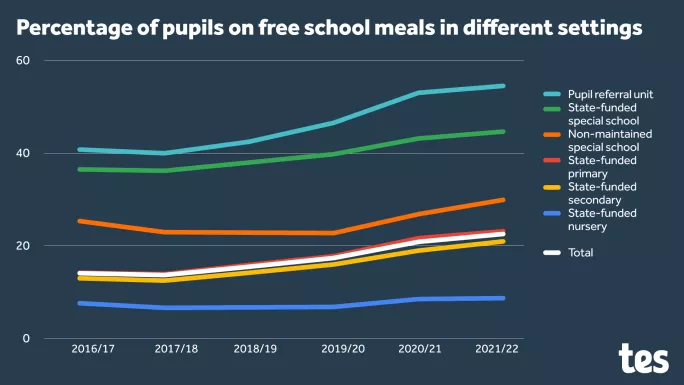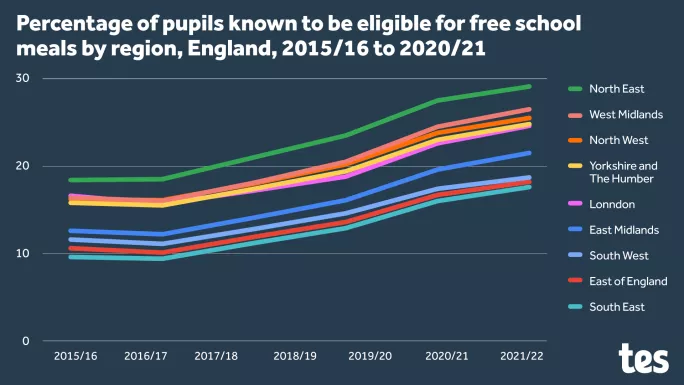Revealed: ‘Shocking’ rise in disadvantaged pupils

Nearly 2 million pupils in English schools were eligible for free school meals at the start of this year, new government data published today shows.
A total of 22.5 per cent of pupils in English schools were eligible for free school meals (FSM) in January, an increase of 160,000 on last year’s figure. The number was described as “shocking” by headteachers’ leaders this morning.
And school leaders’ unions warned that these pupils’ circumstances could become “more severe” due to the cost-of-living crisis, and called for additional funding “for both educational and pastoral support” for them.
- Disadvantage: Pandemic leads to 21 per cent rise in pupils on free school meals
- Scotland: Urgent call for free school meals for all pupils
- Attainment: Rise in free school meals pupils ‘will distort attainment data’
Pupils in England are eligible for FSM if their parent or carer is entitled to certain benefits, such as Income Support or income-based Jobseeker’s Allowance.
The proportion of eligible pupils was rising before the pandemic, from a low of 13.6 per cent in 2018, but shot up to 20.8 per cent in 2021, in the first year after Covid lockdowns hit.
Schools get extra funding - known as pupil premium - for each of their students on FSM, but not all students who are eligible claim FSM.
FSM eligibility varies between different types of school, sitting at 23.1 per cent in state-funded primaries and 20.9 per cent in secondaries - but the figure is far higher in special schools (44.7 per cent) and pupil referral units (54.6 per cent).

In state-funded nurseries - where children are eligible if they meet the criteria and attend for full days - the figure rose to a new high of 8.6 per cent from 8.4 per cent, suggesting that numbers could continue to climb in primaries in the coming years.
The numbers in nurseries had been falling every year since 2015-16 before the pandemic struck.
There is also a big variation in FSM eligibility on a regional level, with 29.1 per cent of pupils in the North East eligible, compared with 17.6 per cent in the South East.

Disadvantage: Calls to extend free school meals in cost-of-living crisis
Paul Whiteman, general secretary of the NAHT school leaders’ union, warned that the children who have become newly eligible for FSM are “disproportionately drawn from more disadvantaged areas and are largely those pupils who already needed more support”, and said that schools were “increasingly struggling” to give this due to “overstretched budgets and the erosion of the value of pupil premium funding since 2015”.
He added: “Additional funding is urgently needed for both educational and pastoral support. Children who are hungry are not ready to learn. Teachers and school leaders are increasingly having to tackle the impact of poverty before they can even start teaching.
“Free school meals eligibility should be extended to every child from a family in receipt of Universal Credit, with auto-enrolment.”
Julie McCulloch, director of policy at the Association of School and College Leaders (ASCL) union, said it was “shocking” to see so many children living in extremely difficult financial circumstances.
“Even more shocking is the fact that current eligibility does not even capture all the children who need help. Free school meal eligibility now applies to 22.5 per cent of pupils, but we know that the level of child poverty is about 30 per cent,” she added.
“We are campaigning, along with other organisations, for all children whose families are in receipt of Universal Credit to be eligible for free school meals in order to extend this support to all those in need.
Rise in the overall number of school pupils
Figures released today also show the rise in the number of pupils in school overall.
There are now over 9 million pupils in English schools - with the figure showing an increase of 88,000 on last year.
Increases have been seen in the number of pupils in state-funded secondary, nursery and special schools and also in independent schools. However, decreases have been seen in primary schools and pupil referral units.
The Department for Education said this was primarily driven by demographic changes, following a peak of births in 2013, with higher numbers of children reaching secondary age and lower numbers of pupils moving into primary school.
The primary population is set to continue to drop to the end of the projection period in 2030, while the secondary population is projected to increase until 2024 then slowly begin to drop.
The number of pupils in independent schools has also increased by 2.1 per cent to 581,400, following a previous peak in 2016-17.
You need a Tes subscription to read this article
Subscribe now to read this article and get other subscriber-only content:
- Unlimited access to all Tes magazine content
- Exclusive subscriber-only stories
- Award-winning email newsletters
Already a subscriber? Log in
You need a subscription to read this article
Subscribe now to read this article and get other subscriber-only content, including:
- Unlimited access to all Tes magazine content
- Exclusive subscriber-only stories
- Award-winning email newsletters



